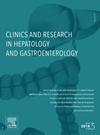Propensity score matching-based analysis of the effect of corticosteroids in treating severe drug-induced liver injury
IF 2.6
4区 医学
Q2 GASTROENTEROLOGY & HEPATOLOGY
Clinics and research in hepatology and gastroenterology
Pub Date : 2024-09-25
DOI:10.1016/j.clinre.2024.102472
引用次数: 0
Abstract
Background and aim
There is no conventional treatment for patients with severe drug-induced liver injury (DILI) except for discontinuation of liver injury drugs and symptomatic supportive therapy. Opinions on whether corticosteroids can be used to treat severe DILI are conflicting, and most of the relevant clinical studies are case reports or retrospective studies, which still need to be supported by high-level evidence-based medical studies. This study aimed to evaluate the effect and tolerance of corticosteroids in patients with severe DILI. Risk factors associated with patient failure to cure were also explored.
Methods
Propensity score matching based on nearest-neighbor 1:1 matching was used to screen severe DILI patients in the corticosteroids and control groups. Severe DILI was defined as elevated serum ALT and/or ALP with TBIL≥5 ULN (5 mg/dL or 85.5 μmol/L) with or without INR ≥1.5. Patients were treated with conventional therapy combined with corticosteroids in the corticosteroids group and only conventional therapy in the control group.
Results
A total of 146 patients, 73 each in the corticosteroids and control groups, were included in this study. By analyzing the entire cohort, we found no significant difference in cure rates between patients in the corticosteroid group and control group (34.2% vs. 20.5 %, p = 0.095), and there was no significant difference in the incidence of adverse effects between the two groups (20.5% vs. 20.5 %, p = 1.000). However, TBIL decreased more in the corticosteroids group on day 7 (89.2 ± 107.6 μmol/L vs. 58.8 ± 70.7 μmol/L, p = 0.046). In subgroup analyses, patients whose TBIL remained elevated despite conventional treatment had a higher TBIL decline on day 7,14 after use of corticosteroid (99.2 ± 98.5μmol/L vs. -23.3 ± 50.4μmol/L, p < 0.001; 120 ± 119.1μmol/L vs. 61.2 ± 98.5μmol/L, p = 0.047). The cure rate of patients in the corticosteroid group was significantly higher than that of the control group (36.1 % versus 4.5 %, p = 0.016). The proportion of patients with TBIL <85.5 μmol/L was also significantly higher in the corticosteroid group than in the control group at day 7 (p = 0.016) and day 14 (p = 0.004) after treatment. In the subgroup analysis of patients with different clinical phenotypes, the causative agent was herbal, autoimmune antibody-positive and 40 % < PTA ≤ 50 % of patients, corticosteroid use did not increase the cure rate of the patients. Univariate and multifactorial analyses found corticosteroid use to be a protective factor for failure to cure in patients with severe DILI (p < 0.001, OR:0.191,95 % CI:0.072–0.470), and peak TBIL to be a risk factor (p = 0.003, OR:1.016,95 % CI:1.007–1.028).
Conclusions
The addition of corticosteroids could not increase the cure rate in patients with severe DILI, but it could rapidly reduce the patient's TBIL at an earlier stage. Corticosteroids could also promote curing in patients with elevated TBIL after conventional treatment. Corticosteroid use was a protective factor for failure to cure in patients with severe DILI and peak TBIL was a risk factor.
基于倾向得分匹配的皮质类固醇治疗严重药物性肝损伤效果分析。
背景和目的:对于严重药物性肝损伤(DILI)患者,除了停用肝损伤药物和对症支持治疗外,尚无常规治疗方法。关于皮质类固醇是否可用于治疗重度 DILI 的观点不一,相关临床研究大多为病例报告或回顾性研究,仍需高水平循证医学研究的支持。本研究旨在评估皮质类固醇对重度DILI患者的疗效和耐受性。研究还探讨了与患者未能治愈相关的风险因素:方法:采用基于近邻 1:1 匹配的倾向得分匹配法筛选皮质类固醇组和对照组中的重度 DILI 患者。严重 DILI 的定义是血清 ALT 和/或 ALP 升高,TBIL≥5 ULN(5 mg/dL 或 85.5 μmol/L),且 INR≥1.5 或不≥1.5。皮质类固醇组患者接受常规疗法联合皮质类固醇治疗,对照组患者仅接受常规疗法:本研究共纳入 146 名患者,其中皮质类固醇组和对照组各 73 名。通过分析整个队列,我们发现皮质类固醇组和对照组患者的治愈率无显著差异(34.2% vs. 20.5%,P=0.095),两组患者的不良反应发生率也无显著差异(20.5% vs. 20.5%,P=1.000)。然而,皮质类固醇组在第 7 天的 TBIL 下降幅度更大(89.2 ± 107.6 μmol/L vs. 58.8 ± 70.7 μmol/L,p=0.046)。在亚组分析中,使用皮质类固醇后,TBIL在常规治疗后仍升高的患者在第7天和第14天的TBIL降幅更大(99.2 ± 98.5μmol/L vs. -23.3 ± 50.4μmol/L,p结论:添加皮质类固醇并不能提高重度 DILI 患者的治愈率,但能在早期迅速降低患者的 TBIL。皮质类固醇还能促进常规治疗后 TBIL 升高患者的治愈。使用皮质类固醇是重度 DILI 患者治愈失败的保护因素,而 TBIL 峰值则是风险因素。
本文章由计算机程序翻译,如有差异,请以英文原文为准。
求助全文
约1分钟内获得全文
求助全文
来源期刊

Clinics and research in hepatology and gastroenterology
GASTROENTEROLOGY & HEPATOLOGY-
CiteScore
4.30
自引率
3.70%
发文量
198
审稿时长
42 days
期刊介绍:
Clinics and Research in Hepatology and Gastroenterology publishes high-quality original research papers in the field of hepatology and gastroenterology. The editors put the accent on rapid communication of new research and clinical developments and so called "hot topic" issues. Following a clear Editorial line, besides original articles and case reports, each issue features editorials, commentaries and reviews. The journal encourages research and discussion between all those involved in the specialty on an international level. All articles are peer reviewed by international experts, the articles in press are online and indexed in the international databases (Current Contents, Pubmed, Scopus, Science Direct).
Clinics and Research in Hepatology and Gastroenterology is a subscription journal (with optional open access), which allows you to publish your research without any cost to you (unless you proactively chose the open access option). Your article will be available to all researchers around the globe whose institution has a subscription to the journal.
 求助内容:
求助内容: 应助结果提醒方式:
应助结果提醒方式:


